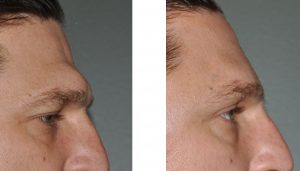Changing one’s bony prominences is the primary method for altering the shape of the face. The face is composed of a variety of bones which have convex and concave contours. The external appearance of the face is highly influenced by the convex bone contours. From the brow bone down to the long curvilinear shape of the mandible, there are numerous key bony projection points. (e.g., cheeks, chin, jaw angles)
Most commonly, a variety of plastic surgery operations exist to enhance or increase their projections. Chin, nose, cheek and jaw angle implants are prime examples. It is almost always easier to increase facial bone projection by adding to the bone rather than actually moving the bone. There are also, however, operations that work in reverse…to reduce or deproject these very same prominences.
Facial bone reductions are not as well known and are less commonly done. Unlike augmentations, facial reduction procedures require modification or shortening of the bony prominences. While some can be shaved down, others require actual cutting off or out of bone sections to change the amount of bony projection.

Cheek reduction is about modifiying the front edge of the cheek bone and its arched form back to where it attaches to the temporal bone. Most patients that want cheek reduction are often Asians in an effort to improve their wider face appearances. A vertical bone cut is made through the body of the malar bone and a wedge of bone is removed. The reduced cheek bone is then attached to the maxilla with a four-hole plate and screws. To get the more posterior part of the arch to move inward, the thin attachment of the posterior part of the zygomatic arch is cut with an osteotome and allowed to move inward (by muscle pull) without the need to secure it.

Chin reduction is done by burring down the genial prominence. While this bone area is simple to get to through a submental incision, chin reductions are notoriously prone to cause soft tissue problems if not done correctly. This is the only facial bony prominence where the soft tissue does not just ‘snap back’ over the bone. If the excess skin and muscle is not removed and readapted back to the reshaped bone, it will sag resulting in the classic ‘witch’s chin deformity. Also, unlike chin bone advancements which can be brought forward 10 to 12 mms or more, retropositioning of the chinbone can not be done as dramatic and is more in the range of 4 to 6mms at best. Going back further than that can have adverse effects on the neck causing undesired fullness.
Jaw angle reduction is most commonly done in Asians like cheek reduction. Through an incision inside the mouth, the angle of the jaw is blunted by an oblique bone cut removing the prominent tip. How much of the tip or angle area is removed is a matter of intraoperative judgment. There is a fine balance between removing too little and completely having no angle at all. A nearly straight line from below the ear to the chin is not desireable either. This is the most uncomfortable of all the facial bony prominences to reduce because the large master muscle must be raised, causing considerable swelling after also.
Barry L. Eppley, M.D., D.M.D.
Indianapolis, Indiana


